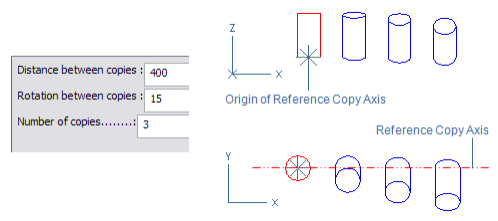 Reference Copy
Reference Copy
You can create duplicates of a primitive or a set of primitives. The resulting 3D objects inherit their properties from the original objects, and if you change the original objects, also the copies are changed accordingly. If you delete one of the original primitives, the whole reference copy set is deleted.
You can also make reference copies of a Boolean primitive that has been created from normal primitives.
You cannot make reference copies of 3D objects that are reference copies themselves, or of 3D objects created with file import (see Import File).
Do the following:
-
On the Component Modeller tab, in the Edit group, click Reference Copy.
-
Select the primitives to be duplicated and press Enter.
-
Pick the origin for the reference copy axis. The origin is used when rotating the duplicates during the copying action.
-
Define the direction for duplication. The resulting axis is also the rotation axis that is used when rotating the duplicates. The rotation angle is measured according to the right hand rule.
-
Enter numeric expressions for the distance between copies, rotation angle (in degrees) around the axis between the copies, and the number of copies to be made, and click OK.
 Show/hide example
Show/hide example
If you have done one leg for a vessel, you can make reference copies of this existing leg. The value of distance between copies is 0, because you want the legs in the same z-level. Some other value would mean the spiral stairs-structure. The total amount of legs is 3, so the value for rotation angle is 120 and the number of copies to be made is 2.
-
You can see the resulting 3D objects. Now you can move the axis of duplication or rotate it. During this move or rotation only the axis of duplication is animated.
-
Press Enter to accept the copies. The reference copies are drawn with the color assigned for reference copies in Tools > Appearance.
-
To edit the duplication parameters, select the Primitive command, select the reference copy, and then Edit Shape from the context menu during the "Pick Action" mode.
